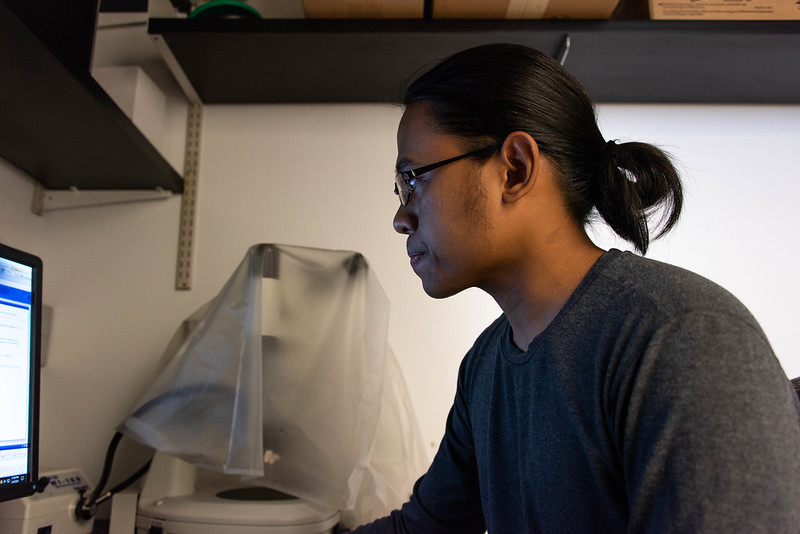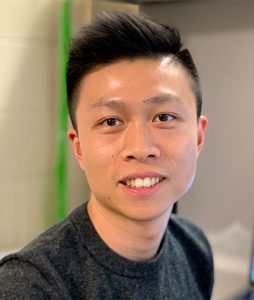June 30, 2021

By Lauren Hines | Bond Life Sciences Center
It’s not surprising that researchers feel discouraged when pursuing projects that involve plant leaf vein density analysis. Manually counting individual leaf veins and measuring their density to understand how nutrients are transported in plants can take weeks of tedious work.
That’s how Janlo Robil was feeling when he was working on a maize leaf project while rotating through the Paula McSteen lab in 2016 in Bond LSC.
Now, researchers can cut that time down to just minutes.
As part of the Bioinformatics in Plant Sciences (BIPS) program, undergraduate and graduate students in plant sciences and computer science have come together to create the first phenotype image analysis system for monocot plant leaf veins called, GrasVIQ.
The GrasVIQ software can process photos of grass leaves, automatically detect and count vertical grass leaf veins and calculate various quantitative measurements such as vein density, width and separation. These measurements help analyze leaf vein network patterns.
“The time that you use for collecting data, you can already use for analysis,” said Janlo Robil, head of the project and graduate student in the McSteen lab. “It will also help you in your decision about the direction of your research because the faster you get the data, then the better idea you have if you still need to pursue this or not.”
The project was spurred by Robil in 2017 when he went to a seminar by Filiz Bunyak, assistant research professor in the Electrical Engineering and Computer Science Department.
Bunyak was presenting her group’s interdisciplinary image processing and computer vision research, including their work on plant phenotype analysis. Robil got the idea to apply it to plant leaf veins.

“It started from a simple question,” said Ke Gao, co-author and graduate student in the Electrical Engineering and Computer Science Department. “Can we help them do their analysis faster with repeatable quantified results? We were hopeful we could use our previous experiences in plant image analysis to help Janlo and his lab conduct their analysis more efficiently.”
However, the project was on hold until 2019. Robil simply didn’t have the time or manpower for this project until he heard about the BIPS program.
“I think [the BIPS program is] a very good way of promoting interdisciplinarity in research,” Robil said. “Had I not asked the computer science people to collaborate with me, I would still be manually counting veins right now, and not using software to quantify veins more quickly. I think interdisciplinarity can move science forward and faster, literally.”
The software can identify the vertical veins with 95% accuracy and 92% accuracy for transverse veins when compared to the manual quantification.
“Without any doubt, we believe that the software can do a better job by just the rate of it,” Robil said.
While the software saves plant science researchers time and energy, it also provides computer science students something as well.
“Collaborating with plant scientists gives us the opportunity to leverage our expertise in engineering, algorithm development, and mathematical models to contribute to the solution of a real-world problem,” Gao said.
BIPS pairs undergraduate and graduate students from plant sciences and computer science together to work on a project. For undergraduate Claire Neighbors in the McSteen lab and computer science undergraduate Michael Boeding, this was their first published paper.
“It’s super exciting,” Neighbors said. “It feels good like all my hard work meant something.”
Neighbors was the one who had to create the images and do the manual counting to compare to the software’s counting. She said the process took her months.
“It was worth something so that we could make this software valid,” Neighbors said. “Someone had to put in the hours to be able to make those ground truths to show that this software works. So, it feels really good that I was able to contribute something.”
While the software has much to offer, the researchers believe it could be better. Robil thinks vein classification can be improved using machine learning even though the software achieves a detection accuracy of more than 90% for vertical veins.
The current software is designed to be used by scientists and does not have a very friendly user interface. Building a better user interface and further improving the analytics using machine learning approaches are future goals for Gao. GrasVIQ will enable generations of training data for these machine learning-based improvements.
Nonetheless, the software provides an escape from endlessly counting veins.
“We learned how to quantify the veins quickly, but like a year from now, that isn’t going to be what’s taking us months to do,” Neighbors said. “It’s going to be figuring out why this gene made the veins look weird or produced less or thinner, thicker, which is going to make things more efficient in the future.”
More information about the project can be found in, “GrasVIQ: An Image Analysis Framework for Automatically Quantifying Vein Number and Morphology in Grass Leaves.” The paper was published on April 29 in The Plant Journal. The study was done by Janlo Robil, Ke Gao, Claire Neighbors, Michael Boeding, Francine Carland, Filiz Bunyak and Paula McSteen. The Bioinformatics and Plant Sciences (BIPS) program is funded under the National Science Foundation, Cellular Dynamics and Function MCB-1818312 to David Mendoza-Cozatl (University of Missouri, Columbia).